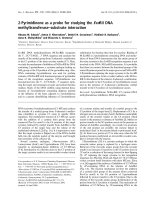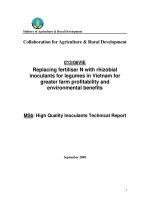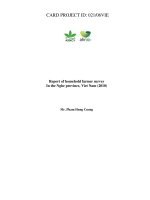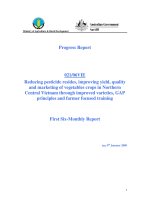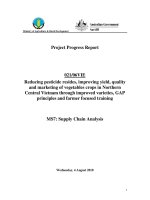Báo cáo khoa học nông nghiệp " Developing a strategy for enhancing the competitiveness of rural small and medium enterprises in the agro-food chain: the case of animal feed - Milestone 4 " ppt
Bạn đang xem bản rút gọn của tài liệu. Xem và tải ngay bản đầy đủ của tài liệu tại đây (43.73 KB, 5 trang )
1
Ministry of Agriculture & Rural Development
Collaboration for Agriculture & Rural Development
Project 030/06VIE
Developing a strategy for enhancing the competitiveness of rural
small and medium enterprises in the agro-food chain: the case of
animal feed
Milestone 4
A. Report on the key issues identified from consultation with major
industry stakeholders
B. Detailed questionnaires developed for data collection from firms in
the livestock feed sector
May 2008
2
A. Key issues identified from consultation with major industry stakeholders
The key issues identified in this report have been collected from a number of sources
including workshops and interviews, as well as stakeholder and field visits over the
period August 2007 to February 2008. They have been used to inform and direct the
questionnaire development, as well as other research work now underway for the final
report: e.g. spatial organization of production and consumption of livestock feed.
Further issues were identified from the desktop review, and these were summarized in
a report for Milestone 3.
1. Key issues identified at the Inception Workshop – August 2007
Key background information: Animal feed is a major cost for animal production
industries (60-80%). The livestock sector is growing at 8-9% per year globally, and
the growth in the domestic animal feed sector is 15% per year. Vietnam needs to
import a lot of the raw material inputs for animal feed and in 2006 40% of raw
material product was imported (mostly soybean and peanut, also corn). Major issues
identified at this workshop included:
• High cost of animal feed in Vietnam – 10 to15% higher than overseas. What is
causing this? Some think that it is mainly because of the high cost of material
inputs.
• Poor quality (and perception of poor quality) of feed produced in Vietnam –
particular that from SMEs. Linked to this is poor capacity for feed quality
control within both smaller feed companies and MARD (DLD). Strategy to
improve capacity for feed quality control is needed (laboratory capacity,
standards, regulations, testing procedures, enforcement).
• SMEs are currently in difficulties, and there are concerns about the future of
SMEs given the dominance of the foreign-owned companies operating in this
sector. Are there policies that could be implemented to improve the
competitiveness of SMEs in the animal feed sector? Domestic companies are
perceived as weaker than foreign ones in terms of three factors which decide
competitiveness: management of quality and technology, after sale service and
material purchasing strategy.
• The high level of material inputs that are imported raise animal feed
production costs. Should material inputs be liberalized? For example, import
materials are subject to 3 kinds of tax (import, VAT and revenue income tax).
There is a need to understand exactly what taxes are paid by the livestock feed
sector on inputs and outputs.
• Linked to the issue of imports, should there be a local materials policy? For
example, how can agricultural and industrial by-products be better used? It
was suggested that if by-products could be used, about 4-5 million more cattle
could be fed, and problems of environment pollution and job opportunities for
rural people addressed.
• Both foreign and domestic mills do not operate to capacity because of unstable
livestock production. More research on producers’ incomes and production
strategies is needed. The strategy of developing networks of producers and
small animal feed mills need to be investigated.
3
• Land for livestock, and credit for both feed production and livestock
production are limiting.
• There are issues with data. It was argued that GSO data underestimates
production from the livestock feed sector, and livestock production from the
household sector because the GSO gets reports on numbers of animals at Aug
1
st
, so they have no idea on how numbers change during the year. Real data is
2 ½ times higher than GSO data for animals (and milled feed?).
• Corn production in Vietnam needs to be increased – there was concern that
this required irrigation investment. What potential is there to increase corn
area and yields?
• What risk analysis strategies are in place in the sector – can hedging be used to
minimize input market risk. Risk analysis associated with food safety issues
should be considered.
• High transport costs – and large costs associated with dealing with a bagged
product – are affecting the sector.
• Need to think about the optimal scale for Vietnam animal feed industry – there
could be a trade off between importing raw materials for livestock feed and
importing livestock meat products.
2. Key issues identified from consultation with various industry experts
Many of the issues raised by the industry experts were similar to those raised at the
inception workshop. Additional issues raised included:
• Low feed quality associated with products from small feed mills – and
associated with this, corruption within the DLD responsible for testing, and
poor enforcement of penalties for breaches of the feed regulations.
• What is a low quality feed?: protein content too low, inaccurate labeling, high
mycotoxins, feed stored in areas with high contamination risk.
• MARD experts said that the quality of feed analysis from laboratories in
Vietnam is not good, especially for food safety contaminants. Results differ
between laboratories. There is a concern that big feed companies sometimes
use growth stimulants in their product. Protein levels are also an issue and
often lower than stated.
• There is no Division of Animal Feed at the provincial level (unlike, for
example, Plant Protection). This contributes to inadequate regulation of feed
quality.
• There are 145 feed businesses producing less than 5000 T/yr (10% of total
production). On the other hand, smallholder livestock production is 90% of
production.
• Production is not matched with mill location – there is oversupply of feed in
some provinces – the spatial location of raw material production, feed
production, and livestock production seems important. Some experts think
there should be a strategy for organising production, others disagree.
• Need to understand if the supply/value chain of the SMEs is different to larger
mills. It was suggested that many small mills only produce concentrate and
sell to remote locations. Is there a niche market for SMEs? Need to look at
4
comparative advantage in the whole value chains (e.g. for large and smaller
mills) and consider social and environmental issues as well.
• Poor and out-dated technology used in small mills. Lack of credit to make
improvements.
• Potential role of the feedmill association to provide feed recipes, training and
laboratories to the SME sector.
• Seasonality in livestock production (particularly pigs).
• Aspects of feed quality that need to be considered:
o Input quality and storage (links to maize harvest month)
o Cleaning of equipment (rats, contamination)
o Accuracy of mix/quality of pellet
o Storage of feed products (antioxidants – fats go rancid and spoil the feed)
o Raw materials should be tested especially if they come from lots of
different locations
o Mycotoxins – cause low feed intake (palatability) – use of mycotoxin
binders (antifungals)
• Technical issues that need to be considered:
o Key technical areas are infrastructure and equipment, throughput capacity
and storage (e.g. a reasonable threshold capacity for a mill would be
5,000T/yr).
o Key differences between mills that will affect competitiveness are:
capacity utilisation, quality control, access to raw materials, marketing
channels, technology.
o Location is another issue – close to port, close to infrastructure, close to
raw materials, close to livestock – where are the mills located?
3. Key issues identified from field visits to feed mills
• Rapidly rising prices of material inputs – at the moment overriding all other
concerns.
• Diversity of feedmill operations – multiple feed products, associated livestock
operations (contract farming), some also operating as traders (usually in
complete feed)
• Differing investment by companies in technology and human development
• Changing management structure of large domestic companies – e.g. from SOE
to equitised company
• The importance of storage capacity and its impact on buying and importing
strategies. Can the GoV play a role in providing storage capacity for SMEs?
• Varying quality control capability in mills – use of laboratories
• Batch size and mill operations generally (throughput capacity (tonnes/hr,
tonnes/day – the smaller the batch size the more the unit/energy cost), repairs
and maintenance scheduling (cleaning of equipment, safety), some feeds
harder to produce (chicken feed and small pigs which need smaller dye)
5
• Pricing arrangements within and outside contracts
• Dealing with seasonal demand – 4 month period August – November (lead up
to Tet), slow increase not large fluctuations
• Selling strategies: some large companies have a selling strategy concentrated
at large agents, and not much to smaller agents operating in remote areas. This
avoids payment risk with farmers as the agents pay the company directly.
• Large companies say that small companies can’t compete: they have no
capital, can’t buy raw materials to store for 6 months, have no advanced
technology, and have to employ too much labour
• Small companies say that their biggest issues are availability of capital and
land, increasing production costs, and the cost of credit from VBARD (1.03%
mth). Often they need to mortgage private assets.
• Small companies say it is difficult to compete with larger companies –
especially in import procurement. Bigger companies can also give agents a
bigger bonus. Some perceive that only competition from large companies is an
issue – competition from other SMEs is not a problem.
• Feed recipe costs are too high for small firms – should the GoV provide
support, especially technical support and training, for small firms? The
software for calculating least cost rations is cheap – but there is insufficient
technical/ management capability to use this in small firms.
• Some small feedmills are not actually mills – they are really just mixing
facilities (producing concentrate)
• There is a perception in large foreign-owned mills that Vietnamese farmers
lack knowledge about correct feeding of livestock (from a nutritional and
growth perspective).
4. Key issues identified from field visits to livestock producers
• Ad hoc use of antibiotics and additives in livestock production
• Odour/water pollution and noise issues for business located in close proximity
to village housing and water supplies
• Producers perceive price of feed to be high
• Perceived (good) quality of feed is a major reason for brand choice, along with
price. Producers judge feed quality on results and company reputation.
• Small holder producers often use complete feed as a concentrate – mixing
complete feed with home grown feed.
